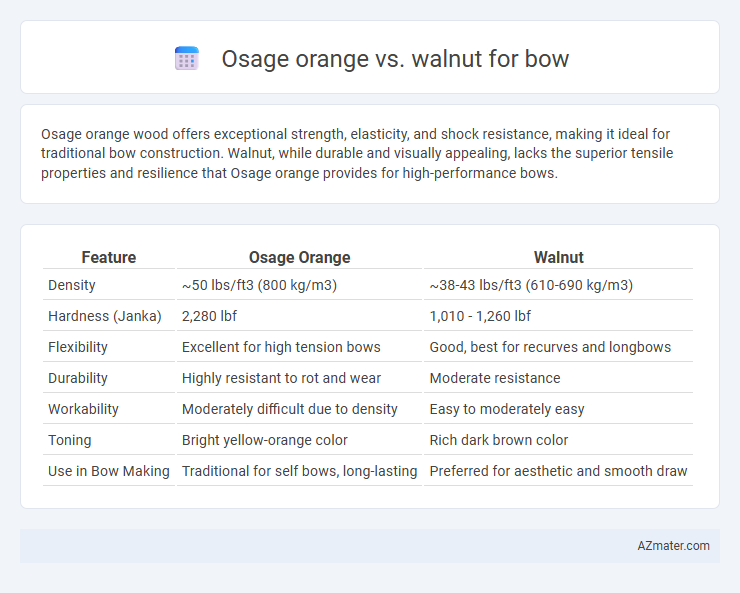Osage orange wood offers exceptional strength, elasticity, and shock resistance, making it ideal for traditional bow construction. Walnut, while durable and visually appealing, lacks the superior tensile properties and resilience that Osage orange provides for high-performance bows.
Table of Comparison
| Feature | Osage Orange | Walnut |
|---|---|---|
| Density | ~50 lbs/ft3 (800 kg/m3) | ~38-43 lbs/ft3 (610-690 kg/m3) |
| Hardness (Janka) | 2,280 lbf | 1,010 - 1,260 lbf |
| Flexibility | Excellent for high tension bows | Good, best for recurves and longbows |
| Durability | Highly resistant to rot and wear | Moderate resistance |
| Workability | Moderately difficult due to density | Easy to moderately easy |
| Toning | Bright yellow-orange color | Rich dark brown color |
| Use in Bow Making | Traditional for self bows, long-lasting | Preferred for aesthetic and smooth draw |
Introduction to Osage Orange and Walnut for Bow Making
Osage Orange and Walnut are two popular hardwoods used in bow making, each offering unique characteristics that affect performance and durability. Osage Orange is prized for its exceptional strength, elasticity, and resistance to rot, making it ideal for longbows and traditional bows that require a strong yet flexible material. Walnut, known for its dense grain and smooth finish, provides moderate strength and excellent shock absorption, favored by bowyers seeking a balance between power and lightweight design.
Wood Properties: Osage Orange vs Walnut
Osage orange wood is renowned for its exceptional strength, density, and flexibility, making it ideal for longbows due to its high tensile strength and ability to absorb shock. Walnut wood, while also strong and durable, is generally less dense and offers greater workability with a smoother finish but may not match Osage orange's superior resilience and elasticity under tension. Both woods have distinct benefits, with Osage orange favored for performance in bowmaking and walnut prized for its aesthetic appeal and ease of crafting.
Durability and Longevity in Bow Construction
Osage orange wood is renowned for its exceptional durability and resistance to wear, making it an ideal choice for long-lasting bows with high tensile strength. Walnut, while durable and flexible, generally offers less longevity under repeated stress compared to Osage orange, as it can be more prone to warping and cracking over time. Osage orange's dense, elastic fibers provide superior stability and resistance to environmental factors, ensuring consistent performance and extended lifespan in bow construction.
Flexibility and Performance Comparison
Osage orange wood is renowned for its exceptional flexibility and resistance to compression, making it a top choice for traditional bowyers seeking durable and responsive bows. Walnut, while valued for its strength and aesthetic grain, generally offers less flexibility and tends to be heavier, impacting the bow's speed and smooth draw. In terms of performance, Osage orange bows deliver superior energy storage and faster arrow speeds, whereas walnut bows provide solid power but with reduced elasticity and slower shot recovery.
Weight and Balance Considerations
Osage orange is prized in bow making for its lightweight properties and excellent flex, offering a balanced feel that enhances accuracy and reduces arm fatigue. Walnut, although heavier, provides superior stiffness and durability, contributing to a more powerful shot but potentially causing quicker fatigue during extended use. Choosing between Osage orange and walnut involves weighing the importance of balance and maneuverability against raw strength and longevity in bow performance.
Workability and Ease of Shaping
Osage orange offers exceptional workability due to its dense, interlocking grain that resists splitting, making it ideal for durable bow limbs though it can be challenging to shape without sharp tools. Walnut is easier to shape and carve, boasting a smoother texture and less density that facilitates detailed craftsmanship but may sacrifice some strength for flexibility. Both woods provide reliable performance in bow making, with Osage orange favored for strength and walnut preferred for ease of working and fine shaping.
Traditional and Modern Bowyer Preferences
Osage orange wood is highly prized by traditional bowyers for its exceptional elasticity, strength, and natural resistance to compression, making it ideal for self bows and longbows. Walnut, favored in both traditional and modern bow making, offers a balance of flexibility and stability, often used for laminated bows due to its workability and attractive grain. Modern bowyers choose Osage orange for durability in traditional styles, while walnut is preferred for versatility and aesthetics in compound and hybrid bows.
Aesthetic Appeal: Grain and Color Differences
Osage orange exhibits a vibrant yellow to orange heartwood with a fine, uniform grain that darkens beautifully with age, offering a striking contrast ideal for visually appealing bows. Walnut, known for its rich chocolate-brown to purplish tones, features a more subdued but elegant grain pattern with occasional curls and waves, adding depth and character to the bow's appearance. The choice between Osage orange's bright, consistent coloration and Walnut's darker, textured aesthetics depends on personal preference for warmth and visual complexity in custom bow craftsmanship.
Cost and Availability of Osage Orange and Walnut
Osage Orange is generally more affordable and widely available in North America due to its fast growth and abundance, making it a cost-effective choice for bowyers. Walnut, particularly black walnut, tends to be pricier and less abundant as high-quality wood suitable for bows is less common and often harvested from mature trees. The relative ease of sourcing Osage Orange combined with its lower price point makes it more accessible for bow crafting compared to the premium cost and limited supply of walnut.
Conclusion: Which Wood is Best for Your Bow?
Osage orange offers superior strength, elasticity, and resistance to compression, making it the top choice for traditional bowyers seeking durability and performance. Walnut wood, while easier to work with and providing good shock absorption, lacks the consistent density and tensile strength that Osage orange consistently delivers. For a bow that combines longevity, power, and reliability, Osage orange remains the best wood option.

Infographic: Osage orange vs Walnut for Bow
 azmater.com
azmater.com